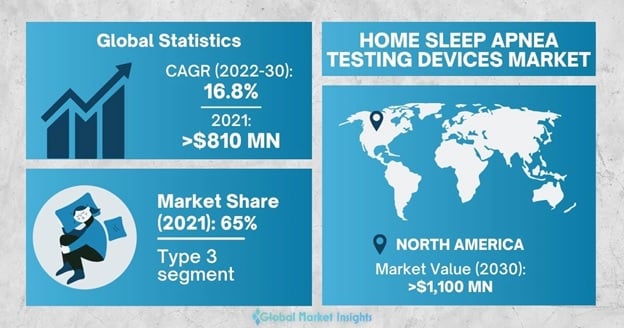Home > Healthcare > Medical Devices > Diagnostic Devices > Home Sleep Apnea Testing Devices Market
Home Sleep Apnea Testing Devices Market Size
- Report ID: GMI4439
- Published Date: Aug 2022
- Report Format: PDF
Home Sleep Apnea Testing Devices Market Size
Home Sleep Apnea Testing Devices Market size registered revenue over USD 810 million in 2021. The industry is projected to depict a CAGR of 16.8% through 2030, given the rising risks of chronic conditions such as heart diseases among patients with sleep disorders.
Sleep apnea tests can diagnose and calculate disease severity by monitoring the oxygen and breathing levels to measure the pauses in breathing across homecare settings. The rising number of patients diagnosed with sleep disorders and other associated co-morbidities will stimulate home sleep apnea testing devices market expansion. According to data from the American Sleep Association, nearly 50 million to 70 million U.S. adults have a sleep disorder, of which, 25 million are suffering from obstructive sleep apnea.
This expanding patient population is opting for devices with reliable and ergonomic designs that aid seamless at-home sleep apnea testing. For example, advanced, wearable sleep apnea testing devices with a user-friendly design, such as Lofta WatchPAT, have been made available for adults. The industry will therefore witness a strong growth trajectory, further influenced by the growing awareness about home sleep apnea tests among consumers.
| Report Attribute | Details |
|---|---|
| Base Year: | 2021 |
| Home Sleep Apnea Testing Devices Market Size in 2021: | USD 811.4 million |
| Forecast Period: | 2022 to 2030 |
| Forecast Period 2022 to 2030 CAGR: | 16.8% |
| 2030 Value Projection: | USD 3,373.4 million |
| Historical Data for: | 2017 to 2021 |
| No. of Pages: | 95 |
| Tables, Charts & Figures: | 81 |
| Segments covered: | Test Type and Region |
| Growth Drivers: |
|
| Pitfalls & Challenges: |
|
Telemedicine has undergone technological advancements over recent years, ensuring seamless access to cost-effective treatments for sleep apnea and other diseases. As an alternative to traditional sleep studies conducted in labs, telemedicine options such as at-home sleep studies are becoming available to diagnose disease symptoms. It can also help patients select the right CPAP (continuous positive airway pressure) device and access ongoing monitoring. These innovations in telemedicine technologies will generate lucrative opportunities for market growth over the forecast period.

